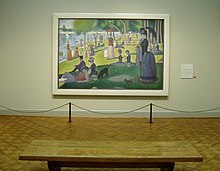A Sunday Afternoon on the Island of La Grande Jatte
| A Sunday Afternoon on the Island of La Grande Jatte - 1884 | |
|---|---|
 | |
| Artist | Georges-Pierre Seurat |
| Year | 1884–1886 |
| Type | Oil on canvas |
| Location | Art Institute of Chicago[1] |
A Sunday Afternoon on the Island of La Grande Jatte - 1884 (French: Un dimanche après-midi à l'Île de la Grande Jatte - 1884) is one of Georges Seurat's most famous works, and is an example of pointillism.
Overview
Georges Seurat spent over two years painting A Sunday Afternoon, focusing meticulously on the landscape of the park. He reworked the original as well as completed numerous preliminary drawings and oil sketches. He would go and sit in the park and make numerous sketches of the various figures in order to perfect their form. He concentrated on the issues of colour, light, and form. The painting is approximately 2 by 3 meters (6 ft 10 in x 10 ft 1 in) in size.
Motivated by study in optical and colour theory, Seurat contrasted miniature dots of colors that, through optical unification, form a single hue in the viewer's eye. He believed that this form of painting, called divisionism at the time but now known as pointillism, would make the colors more brilliant and powerful than standard brush strokes. The use of dots of almost uniform size came in the second year of his work on the painting, 1885-86. To make the experience of the painting even more vivid, he surrounded it with a frame of painted dots, which in turn he enclosed with a pure white, wooden frame, which is how the painting is exhibited today at the Art Institute of Chicago.
In creating the picture, Seurat employed the then-new pigment zinc yellow (zinc chromate), most visibly for yellow highlights on the lawn in the painting, but also in mixtures with orange and blue pigments. In the century and more since the painting's completion, the zinc yellow has darkened to brown—a colour degeneration that was already showing in the painting in Seurat's lifetime.[2]
The island of la Grande Jatte is in the Seine in Paris between La Defense and the suburb of Neuilly, bisected by the Pont-de-Levallois. Although for many years it was an industrial site, it is today the site of a public garden and a housing development. When Seurat began the painting in 1884, the island was a bucolic retreat far from the urban center. The painting was first exhibited in 1886, dominating the second Salon of the Société des Artistes Indépendants, of which Seurat had been a founder in 1884.
Acquisition by The Art Institute of Chicago

In 1923 Frederick Bartlett was appointed trustee of The Art Institute of Chicago, he and his second wife Helen Birch Bartlett loaned their collection of French Post-Impressionist and Modernist art to the Museum. It was his wife Helen who had an interest in French and avant-garde artists and influenced her husband's collecting tastes. Sunday Afternoon on the Island of La Grande Jatte was purchased on the advice of the Art Institute of Chicago's curatorial staff in 1924.[3]
In conceptual artist Don Celender's 1974-5 book Observation and Scholarship Examination for Art Historians, Museum Directors, Artists, Dealers and Collectors one of the questions is "How much did The Art Institute of Chicago pay for Seurat's Sunday Afternoon on the Island of la Grande Jatte in 1924?"[4] with the answer given as $24,000.00, although as the painting is currently held in The Art Institute of Chicago's Helen Birch Memorial Collection it is unclear as to whether this answer is correct or whether the Institute assisted the Bartletts in their purchase of it.[5]
Pop Culture
The painting was the basis for the 1984 Broadway musical Sunday In The Park With George by Stephen Sondheim and James Lapine. Subsequently the painting is sometimes referred to by the misnomer "Sunday in the Park".
The painting was featured in the 1986 comedy film Ferris Bueller's Day Off, in which Cameron Frye (played by Alan Ruck) fixates on the painting during a visit to the art museum while skipping school with the film's title character.
The painting appears in the 1987 graphic adventure game Maniac Mansion, where it is seen hanging the Edison family dining room.
More recently, a parody of the painting has been used for a promotional poster of the American tv series The Office which features all the main characters from season 8 of the series.
Related works by Seurat
-
Study for La Grand Jatte, 1884 Zoom
-
Figures assises, 1884
-
Die Insel La Grande Jatte mit Ausflüglern, 1884
-
Paysage et personnages, 1884–1885
-
Groupe de personnages, 1884–1885
-
Esquisse d'ensemble, 1884–1885
-
Femmes au bord de l'eau, 1885–1886
References
- ^ Roch, Christine L. "From "Rube Town" to Modern Metropolis:". Retrieved 04/08/2011.
{{cite web}}: Check date values in:|accessdate=(help) - ^ Gage, John (1993). Color and Culture: Practice and Meaning from Antiquity to Abstraction. Boston: Little, Brown. pp. 220, 224..
- ^ [1]
- ^ Celender, Don (1974-5). Observation and Scholarship Examination for Art Historians, Museum Directors, Artists, Dealers, and Collectors. Publication was produced for an exhibition held at the O.K. Harris Gallery, 383 West Broadway, New York, from December 7 to December 28, 1974. pp. Question: Page 5, Answer: Page 23.
{{cite book}}: Check date values in:|year=(help) - ^ [2]
External links
- Seurat and the Making of La Grande Jatte
- La Grande Jatte - Inspiration, Analysis and Critical Reception
- http://www.artic.edu/aic/collections/artwork/27992







